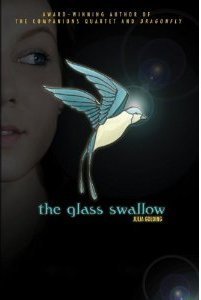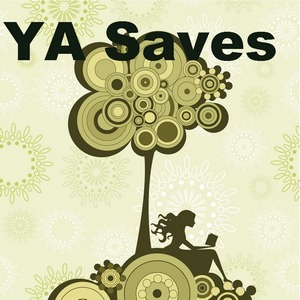Cheryl Rainfield's Blog, page 103
June 30, 2011
review of YA fantasy The Glass Swallow by Julia Golding
The Glass Swallow
Julia Golding
Marshall Cavendish (October 2011) (pre-order)
ISBN-10: 0761459790
ISBN-13: 978-0761459798
My review: 5/5 stars
I have found another YA fantasy author who has quickly become a favorite of mine–Julia Golding. (You can bet I'm going to run out and find all of her other books now.)
The Glass Swallow is a wonderful read–it has a strong girl character; suspense and danger; romance; and the strong girl pulling together everything to make things work out.
In The Glass Swallow, Rain designs stained glass windows in secret; in her land, it is forbidden for women to do so. But her designs are beautiful, and capture the attention of a neighboring kingdom. She pretends it is her cousin who designs them, and they make a temporary proposal of marriage. Her cousin is asked to design their neighboring kingdom's summer palace, and Rain goes along. Once she arrives, her entire party is killed, and Rain is left to fend for herself in a strange land that devalues people who work in the trades, especially those with birds and animals. Rain works her way into the hearts of others, finds true love, and once the kingdom collapses, is key in recreating it to become a better, happier land.
This is one of those books that I didn't want to end. I quickly came to care about Rain immensely, and Peri (the love interest) as well, rooting for them every step of the way. I loved Rain's inner strength, her fiestiness and courage, and her insight and talent, and Peri's goodness and courage. It helped that there were loving, full-rounded characters, such as Rain's dad and the bondsman Rain became friends with, to offset the slimy or ugly characters; the mix worked beautifully. There was only one very small thing that I didn't believe, and that was Ret's movement from a spoiled young man to a mature, aware one–but that did not take away from my enjoyment of the story. I was with Rain and Peri every page, believing in their characters, their desires and motivations, their dreams. Julia Golding created a wonderful world that kept me enthralled.
Highly recommended! If you like fantasy, pre-order yourself a copy! Fans of Tamora Pierce will gobble this one up.
source: ARC obtained at ALA in New Orleans
June 18, 2011
YA anthology donates proceeds to The Trevor Foundation
The YA anthology AWAKE donates all the net proceeds to The Trevor Project (preventing suicide among LGBTQ youth). WOW, eh? The anthology has stories of lesbian, gay, bisexual, and transgender teens written by YA authors Nancy Garden, Robin Reardon, Brian Katcher, and Kathe Koja. Sounds like a good collection and a worthy cause!
June 17, 2011
Guest Post by YA author Joe Lunievicz: Call Me Ishmael
Today YA author Joe Lunievicz is guest blogging here. I enjoyed reading his post; I hope you do, too! I think openings in books are just as important as Joe does. Take it away, Joe!
Call Me Ishmael
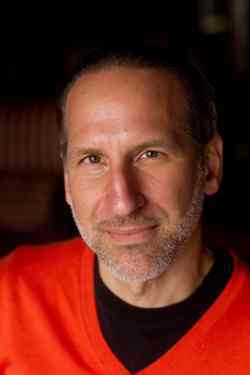 Don't get me wrong – I love book covers. When I'm browsing in bookstores book covers are the first thing that either attracts me or pushes me away from a book. But after the cover it's all about the opening line.
Don't get me wrong – I love book covers. When I'm browsing in bookstores book covers are the first thing that either attracts me or pushes me away from a book. But after the cover it's all about the opening line.
I know, as a writer, that I have to grab the reader right away. This has been brought home to me over and over again in writing classes and workshops, but it never really hit me until I read Scar Lover by Harry Crews. The first line is, Pete Butcher had not meant to speak to her. The next two paragraphs begin like this: He felt a little chill on the back of his neck, and with the chill came the thought that she wanted to tell him something. And, People were forever telling him something he did not want to hear. Something bad. And we're off and running. I had to read this book because of the first line and what followed in the first three paragraphs. But the first line has to hook.
So I spend time on my first line.
I spend a lot of time on it and I think most writers do too. Andrew Smith, author of Ghost Medicine, In the Path of Falling Objects, and The Marbury Lens, has told me he rewrites his first lines over and over again until they are perfect.
So what should the first line do?
It needs to grab the reader, yes.
But it also needs to give a frame for all that will come. It's a tall order, in just one line. In the case of the protagonist, Pete Butcher, in Scar Lover, the woman he meets and speaks to becomes the whole reason for the tale. It tells us about the trepidation of the protagonist, the hesitancy he has to meet new people because of the horrible things he has been told in the past, and the importance of chance in what is to come.
Look at Cheryl Rainfield's opening line in her novel, Scars.
"Someone is following me." I gulp air, trying to breathe.
Right from the start we are on a chase. The protagonist – Kendra – is afraid and we can tell immediately that she is also in danger. She's talking to her therapist but the feeling of being not-believed, of being trapped begins with the gulping of air and continues in the next few sentences with, a voice that stings, hands that twist, words that are spit and lips that are dry. Everything follows from the opening line. In Cheryl's case the tension level of the story is high from that opening line, continues with sensory details that speak to strong emotions, and promise a narrative that will not release us until the very last line of the book. Scars does just that. It grips, makes it hard to breathe, and makes us worry what will happen to a girl who is always looking over her shoulder to see who is following her.
In the case of my book, Open Wounds*, it took me four years to find the first line, even though revisions continued on other parts of the book for three more years. But when I found that line I knew that was the way I wanted readers to start the journey of Cid Wymann – the protagonist of my story.
"It begins with blood and ends with blood," begins Cid's tale. It's 1936 and seven year old Cid Wymann has been looking at an advertisement in The New York Times for the movie, Captain Blood starring Errol Flynn – the Heath Ledger of his time. But Cid's mother, we also find out within the first two paragraphs, died giving birth to Cid. The blood of his mother and the blood of Swashbucklers begins the tale, setting terrible hardship and adventure hand in hand. The question becomes whose blood are we talking about ending the book with? Is it Cid's or another's? Is it one person's or many? Cid presents you with his own mystery, the mystery of his life and asks you to come along as he proceeds to lay it out for you.
When you're writing your own novel, or short story, think about your first line, and spend time on it. It doesn't have to be perfect at first. Wait until you have your ending so you know the whole take you're going to tell, then go back and take another look at that first line. Does it still grab the reader? Does it frame what is to come right from the start?
Remember, if you have readers like me, you have only the cover, a first line, and maybe the first couple of paragraphs to grab me and keep me, before I move on to another book on the shelf. If you are looking for an agent or publisher, you don't even have the cover. All you have are those words and the opening words have to be, well… perfect for the tale you are going to tell.
See if you can match the following opening lines of some of my favorite YA novels to the books that they come from.
1. The end of the world started when a Pegasus landed on the hood of my car.
2. The best day of my life happened when I was five and almost died at Disney World.
3. The temperature of the room dropped fast.
4. Sixteen is too young to lose your mother, people kept telling me.
5. "Somebody must have told them suckers I was coming."
6. I'm under Momma's coffin.
7. The women resemble schoolgirls with gangly limbs, ruddy cheeks, plaited flaxen hair; they walk holding hands.
8. Our brother fell apart in the war.
9. I was six.
10. He waited on the stoop until twilight, pretending to watch the sun melt into the dirty gray Harlem sky.
a. Ghost Medicine, Andrew Smith**
b. The Contender, Robert Lipsyte
c. The Amulet of Samarkand, Jonathan Stroud
d. Madapple, Christina Meldrum
e. In the Path of Falling Objects, Andrew Smith**
f. Crossing the Tracks, Barbara Stuber
g. Stitches, David Small (note this is a graphic novel)
h. Going Bovine, Libba Bray
i. The Last Olympian, Rick Riordan
j. Fallen Angels, Walter Dean Myers
* Open Wounds is the story of Cid Wymann, a scrappy kid fighting to survive a harsh upbringing in Queens, NY during the 1930's and 1940's. Almost a prisoner in his own home his only escape is sneaking to Times Square to see Errol Flynn movies full of swordplay and duels. He's determined to become a great fencer, but after his family disintegrates, Cid spends five years at an orphanage until his injured war-veteran cousin "Lefty" arrives from England to claim him. Lefty teaches Cid about acting and stage combat, especially fencing and introduces Cid to Nikolai Varvarinski, a brilliant drunken Russian Fencing master who trains Cid. By 16, Cid learns to channel his aggression through the harsh discipline of the blade, eventually taking on enemies old and new as he perfects his skills. Evocative of The Book Thief with a dash of Gangs of New York, Open Wounds is the page-turning story of a lost boys' quest to become a man.
**In Andrew Smith's two books the opening lines are from the first chapters of each book. Both books also have prologues. Read them and tell me what impact each of them has on you.
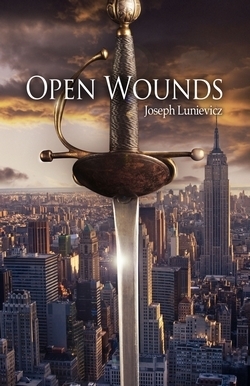 Joe Lunievicz is the author of Open Wounds. In Open Wounds, Cid Wymann, a scrappy kid fighting to survive a harsh upbringing in Queens, NY, is a almost a prisoner in his own home. His only escape is sneaking to Times Square to see Errol Flynn movies full of swordplay and duels. He s determined to become a great fencer, but after his family disintegrates, Cid spends five years at an orphanage until his injured war-veteran cousin Lefty arrives from England to claim him. Lefty teaches Cid about acting and stage combat, especially fencing, and introduces him to Nikolai Varvarinski, a brilliant drunken Russian fencing master who trains Cid. By 16, Cid learns to channel his aggression through the harsh discipline of the blade, eventually taking on enemies old and new as he perfects his skills. Evocative of The Book Thief with a dash of Gangs of New York, Open Wounds is the page-turning story of a lost boy s quest to become a man.
Joe Lunievicz is the author of Open Wounds. In Open Wounds, Cid Wymann, a scrappy kid fighting to survive a harsh upbringing in Queens, NY, is a almost a prisoner in his own home. His only escape is sneaking to Times Square to see Errol Flynn movies full of swordplay and duels. He s determined to become a great fencer, but after his family disintegrates, Cid spends five years at an orphanage until his injured war-veteran cousin Lefty arrives from England to claim him. Lefty teaches Cid about acting and stage combat, especially fencing, and introduces him to Nikolai Varvarinski, a brilliant drunken Russian fencing master who trains Cid. By 16, Cid learns to channel his aggression through the harsh discipline of the blade, eventually taking on enemies old and new as he perfects his skills. Evocative of The Book Thief with a dash of Gangs of New York, Open Wounds is the page-turning story of a lost boy s quest to become a man.
You can visit Joe at lunievicz.com
June 13, 2011
Interview with YA author C Lee McKenzie
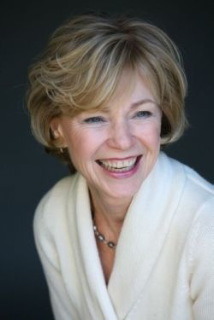
Today I talk with YA author C Lee McKenzie about her writing, her books, and more. C Lee McKenzie is the author of The Princess of Las Pulgas and Sliding On the Edge.
Why do you write?
I think I'm a reader who had this desire to be on the other side of that reading process. I forget who said this, but it applies to me. "Writers are readers who suddenly want to emulate." That's probably not a quote, but it's close.
What do you love about writing? (Or about the publishing business, or both.)
I love to create people who have a story to tell, then let them tell it. I also love to make a story the way I want it. Of course, it's not as easy as I thought it would be. I've found that sometimes those people and those stories take off in directions they want, not necessarily what I had planned. So I guess the surprises have also turned out to be what I love in this writing business.
What don't you like about the publishing business? (Or about writing.)
I hate waiting, and authors spend a lot of time doing that. I've had to learn about patience and about occupying myself while I WAIT for someone to read my story, WAIT for someone to comment on it, WAIT for someone to like it enough to buy it, WAIT for the edits, WAIT for publication, WAIT for the reviews. I have a blog called the Write Game; if I'd known more when I started it, I would have called it the Wait Game.
I understand! (laughing) It's hard to wait, and as writers we often have to wait a long time, even just to have the book published after signing the contract.
What would you want in your ideal writing studio? What does your writing space look like now?
I'm really lucky to have my ideal writing studio. It's a full wall of windows looking out over a forest of Redwood trees and down into a garden. The only thing that's not exactly perfect (*laughing here*) is my desk. When I start the day it's usually beautiful–organized, neat, everything within reach that I'll need. By the end of the day the desktop looks like I've cultivated it and forgotten to rake it smooth. I sometimes have my lap top out alongside my desk top because there's something on one and not the other, and then there are the piles of books and notes. Coffee cups, of course, and snack remains. Total chaos around me, but inside my computers I might have some good writing.
Your studio sounds beautiful! And I think a lot of us writers and creative people can relate to being messy.
Where do you write most often?
I usually write at my desk. I often print out and take drafts outside to read and edit. If I'm away from home, I make notes in a journal I carry or on my laptop. Then, of course, there are the wrinkled scraps in my pocket that have notes I've written while standing in the grocery store check out or waiting in the car for the light to turn green. I've found story details on the backs of receipts for gas, shopping bags, even my checkbook register. I've discovered that thinking is a messy process for me; when I write I'm all about clutter. The fun part is to pull all of that into something that people want to read.
I love that you make notes on anything around you! I do that, too.
What do you think is the most important thing (or things) that makes a good book work?
I think first, it's the characters. Readers have to connect with the people inside a book; they have to care about them and their stories. If the people aren't believable, the story doesn't work, and that applies to Werewolves and Goblins as well as realistic men and women.
Yes, characters are important.
What is your favorite type of book to read?
That's a hard question to answer, since read all kinds of books. But I guess I'd have to say that my first choice is a gripping novel, and that can be realistic as well as fantastic. I love biographies and historical fiction too. I drive my husband crazy because I'll start to read one book, then pick up another. I often read two or three books at the same time.
What are some of your favorite YA books? How about picture books?
I really love S. E. Hinton's books. They're dated, but I still think of them as young adult books I can relate to. Jane Yolan's books are also right up there when I think "favorite." As to PBs. There's a Griffin in My Garden has always been a favorite in our family. In fact, we had a stone griffin made for our garden, and it stands looking out over the flower and vegetable garden to this day. I almost believe it's steamy breath is what brings our plants to life quickly and makes them bloom. That's part of the story we love.
S. E.Hinton's books are some of my favorites, too.
How much of yourself or your own experiences and emotions do you put in your books?
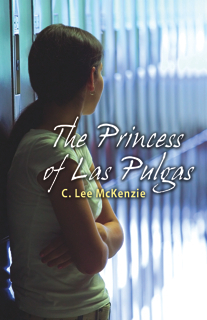 I suppose there's some of me in those books; it would be impossible to separate all that I am from my writing, but I've never really had the experiences that I write about. I've never been abandoned or mistreated; I've never thought of cutting myself like Shawna in Sliding on the Edge. I have moved a lot, so the angst of new places and new schools is something I can relate to, and I did use some of those feelings when I wrote Princess of Las Pulgas.
I suppose there's some of me in those books; it would be impossible to separate all that I am from my writing, but I've never really had the experiences that I write about. I've never been abandoned or mistreated; I've never thought of cutting myself like Shawna in Sliding on the Edge. I have moved a lot, so the angst of new places and new schools is something I can relate to, and I did use some of those feelings when I wrote Princess of Las Pulgas.
What is your favorite book that you wrote? Why?
I don't think I've finished my favorite book yet. It's still at about fifteen chapters and it's based on my father's early life as the son of an immigrant family. I've set it aside for a while, but I'll get back to it once I'm sure how I want the story to develop from where I stopped writing.
What do you want to tell readers?
I want to tell them thank you. I appreciate them. I appreciate that they took their valuable time to read what I set down.
Where can readers find you online?
I blog at http://writegame.blogspot.com and my website is http://cleemckenziebooks.com. I hope they'll stop by, say hello and tell me what they think of my books.
What are you working on now? Or what's your next book that we can look for?
I've submitted a book about an abused and abandoned boy who's on the way to a life in prison if no one steps in to help. Fortunately, there are two people in my story that find this boy worth their effort; one is a priest and one is a retired teacher. The teacher will have the biggest effect on Hutch (the boy), but she's fighting a losing battle with Alzheimer's, so there's a bittersweetness in her success.
That sounds really interesting, Lee!
You've asked some challenging questions, Cheryl. They were interesting to answer. Thanks so much for opportunity to be here on your wonderful blog.
I'm very happy you stopped by.
I made a #YAsaves image for myself
I felt so supported, moved, and empowered by the whole #YAsaves movement and everyone who's raised their voices to support SCARS in the face of the WSJ article, that I decided to create an image that meant that to me. I found a great image at iStockphoto (which I bought), added text, and I've ordered two keychains which I'm going to attach to my luggage. I'm hoping they arrive before ALA! I also ordered three pads of sticky notes, and if they arrive before ALA, I'll bring them and the first three people to ask me for them will get them.
Meanwhile, I'm going to add the image to my blog. It's such a positive visual reminder for me of our vibrant YA lit community and all the incredible support I received. I am not alone any more when I feel attacked or in pain–it's such an incredibly good feeling!
So here's the image. What do you think?
PS I'm happy to share the image with anyone who wants to use it if I legally can. I *think* I can since I bought the image for use on iStockPhoto….? Any one know?
June 10, 2011
Cover Reveal: The Cover For HUNTED!
I just got the cover for HUNTED (coming out this Oct), and I am SO thrilled! I LOVE it. I think it has both the tension and the feeling of the book, while saying visually that it's a fantasy.
In HUNTED, Cassie is a telepath in a world where that is illegal. She is on the run from the government troopers, trying to stay hidden and alive–and trying to help make the world a better place for others with paranormal talents.
I'm very lucky to have the wonderful publisher and editor that I have. I got to work closely with WestSide on the cover of HUNTED–something that not every author gets to do.
I think covers are important in helping to get a book out there–a bad cover can turn you off. So I'm delighted with this cover!
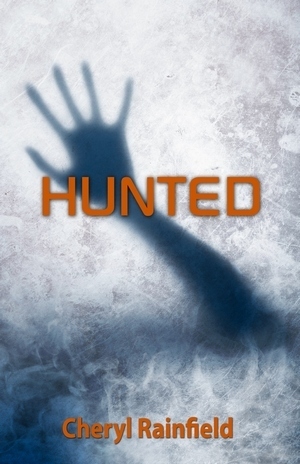
…What do you think? Do you like the cover? Or not like it?
If you want to read more about Hunted, check out this post.
Self-Harm Is NOT Trendy
Many people are misinformed about self-harm. Gurdon is one of them; in her June 2011 MPRNews interview she says that "self-mutilation is almost trendy."
Whoa, there! Self-harm is never trendy.
Self-harm usually comes from intense, overwhelming emotional pain or other overwhelming emotions–basically, great emotional distress. Often, the emotional pain is so bad that inflicting physical pain is a distraction and a relief from the emotional pain. I sometimes used self-harm to keep myself from killing myself, and others have used it that way, too.
Most people who use self-harm are survivors of sexual abuse, trauma, or some form of oppression (such as being queer in a homophobic world).
Self-harm is a serious issue, and it is widespread. The CASE (Child and Adolescent Self-harm in Europe) study found that 3 in 10 girls and 1 in ten boys have either self-harmed or considered doing so. (I think it could be higher), and that 1 in 4 cases of self-harm goes unreported.
There are hugely detrimental effects to self-harm, even though self-harm can be what helps a teen cope with trauma or severe abuse.
Emotional Detrimental Effects of Self-Harm
-increased sense of isolation
-shame
-having to watch what you say and do; the self-harm becomes a secret to hide (which, for incest and ritual abuse survivors can be triggering, since the abuse was the first secret)
-social awkwardness (Most of us go to great lengths to hide our wounds and scars, wearing long sleeves or pants even in hot weather (arms & legs are the most common places to self-harm); not wanting to change in front of anyone, including peers (which causes problems in gym class, swimming, etc), not wearing revealing clothing; etc).
-negative attention (which increases the emotional pain, shame, etc): people often harshly judge self harm, and often: get angry at us; blame; accuse us of trying to manipulate or to get attention (all myths–see this article for more information); try to control us; punish us; may try to hospitalize us. Though I often cut so deeply I needed stitches, I never went to see a doctor. I was afraid of the reaction.
-lack of respect Often doctors and health-care professionals can treat people who self-harm with a lack of respect and with anger, blaming us. I had a friend who used self-harm where the doctor refused to give her freezing for the pain as he was stitching her up because he said she did this to herself, and I've heard about this from others. We do not like pain–I went out of my way to avoid it, except when I could not bear the emotional pain any more.
-scars. I have often had people stare at my old scars, had strangers come up to me and ask what happened or make offensive remarks such as "I love your body tattoos." Or, in the case of Gurdon, calling my arm "horribly scarred." My arm is scarred, yes. It is not horrible and I don't find it repulsive to look at. I accept my scars; they are a part of my history and my survival.
Physical Health Risks:
-infection, which can become very serious
-nerve damage (I had some nerve damage in my feet, and a friend of mine almost lost the use of her hand)
-tendon damage which can lead to a loss of mobility
-increasing damage to the body. Since the effect of relief from the emotional pain (or other reasons we use self-harm) seems to lessen over time, the need to self-harm often increases–in frequency and severity.
-physiological shock Untreated shock can kill you.
-severe blood loss or possible death by mistake if hit an artery; you likely won't have time to get help.
You can read more about some of the possible physical effects and ways to deal with them in Self-Harm: Limiting the Damage leaflet and First Aid For Self-Injury on Secret Shame.
Self-harm is not trendy in any stretch of the imagination.
And talking and reading about self-harm does not encourage self-harm. It can have the opposite effect. I get reader letters every week from teens (and adults) telling me how Scars helped them stop cutting, or want to stop cutting, seek out therapy, talk to someone for the first time about their self-harm or sexual abuse or being queer.
Talking and reading about self-harm, and knowing you're not the only one, can help. I know this from persona experience; I also know it from my reader letters. For teens who self-harm, it helps to know they're not alone. For teens who've never been through it before, it helps give them more compassion and awareness, and helps them be better able to deal others who self-harm. We need to know that we are not alone, that we are not the only one who copes in this way. To feel alone in your pain only increases the pain. Finding that you're not alone helps decrease the pain, and helps you cope.
YA author Diane Duane also found this true in her experience as a psychiatric nurse; she said that: "What I found while doing one-to-one therapy with adolescent patients is that to successfully start working through their problems, what they initially needed more than anything else was confirmation and acknowledgement from those around them that the problems existed in the first place – that they weren't unique or alone in their situation, that other people knew about it and that it was real. Books dealing with the problem in question were and are often a useful tool to help that acknowledgement get started, and even (in some cases) in getting a patient past their own denial that they had any such difficulty at all."
I think that the way to help encourage healing and greater compassion is to look at and talk about the painful experiences–and one of the safest ways to do that is through reading. I know that as a teen being sexually abused, I would often give someone a passage to read from a book to try to help someone understand. I wish I'd had such a book to help others understand about self-harm. That is part of why I wrote Scars.
Being able to talk about self-harm openly, and have the person respond with compassion and understanding can help encourage healing. It did for me (as well as looking at the underlying causes).
I think attitudes like Gurdon's on self-harm are dangerous. They increase the ignorance and myths about self-harm, and encourage head-in-the-sand thinking. Self-harm exists. It needs to be talked about.
You may also want to read my articles and tips on self-harm:
Reasons Not To Hurt Yourself
Alternatives To Self-Harm
Helpful Responses to Someone Who's Self-Harmed
How To Stop Self-Harming
What To Do When You Feel Like Harming Yourself (long)
Some more good resources are:
Secret Shame (highly recommended)
Cutting and Self-Harm
June 8, 2011
I speak out again, this time on IRA's Engage
I speak loudly again about the WSJ article that slammed Scars, and about #YAsaves & the wonderful support of the YAlit community, this time on IRA's Engage: From Pain to Empowerment.
June 5, 2011
YA Saves – Cheryl Rainfield speaks out
Yesterday WSJ slammed realistic, gritty YA books for being "rife with explicit abuse, violence and depravity", suggesting that books on such painful topics will make teens ugly, or even, in the case of self-harm, encourage such behaviors. Scars was one of the books that the WSJ slammed.
My initial response was pain, falling into triggers, and being afraid to say anything in response–though I did manage to think that at least WSJ had put me and Scars in good company. My abusers frequently threatened to kill me if I spoke out, criticized me (that's putting it lightly) constantly, and hated me for fighting the abuse and trying to protect other victims during the abuse. It's so easy for me to hear someone criticizing me–or my book SCARS which has so much of my soul and experiences of incest, self-harm, & being queer–and to have that block out all positive. That's a reaction that I was deliberately taught by my abusers, and sometimes it's hard to shake myself out of.
But then a few people started mentioning Scars and the WSJ article on Twitter, supporting Scars, and I found myself peeking out of my triggers, and remembering how many times I've been told Scars has helped readers. I get 2-3 reader letters every week telling me that Scars helped readers–teens telling me that Scars helped them to stop cutting, get into therapy, know they're not alone, talk about incest or self-harm or being queer when they never had been able to before. That is what I want to hold on to. That is what I want to remember.
And then the amazing YA author Maureen Johnson asked us all on Twitter: "Did YA help you? Let the world know how! Tell your story with a #YAsaves tag. And copy the @wsj for good measure." And the Twittersphere explodedwith YA writers, librarians, readers, bloggers all been raising their voices to show why YA books that deal with gritty issues are important. So many people joined in that yesterday #YAsaves became the #3 trending topic in the US. And within that discussion, I found myself moving from hurt to empowerment and strength. (You can still join in on Twitter, or the archive of YAsaves tweets here: http://dft.ba/-ut9)
The WSJ article actually suggested that if teens read books on self-harm like Scars it would make them want to cut, even if they had never been drawn to that behavior before. I wonder if Meghan Cox Gurdon, the author of that article, even read SCARS? I can't believe that anyone who read the deep and raw emotional pain in SCARS would ever want to cut–and teens have told me it makes them want to stop or never start. Talking about painful issues and experiences is not advocating them–it is breaking silence and encouraging healing.
I could not have survived my child- and teenhood without books. YA fantasy books helped me escape the abuse and torture I was living, and YA realistic books helped me feel less alone. Books helped me hope and dream for safety, love, and kindness, and helped me realize that not everyone was as deliberately cruel as my abusers.
But growing up being sexually abused and raped by both my parents (who were part of a cult), being ritually abused, using self-harm to cope, wanting to die and sometimes being serious about suicide, being queer…I couldn't find enough of myself in the books I read, not back then. I found fragments that helped me feel less alone–Judy Blume's Blubber helped me know I wasn't alone in being bullied at school, when I was no longer a teen Annie On My Mind helped me know I was not alone in being queer. But I needed more. And I knew other teens did, too. So I wrote SCARS.
There's so much societal judgment about using self-harm, being queer, and often about being an incest survivor. People tell us not to talk about it, or blame us for what we've been through or what we feel. And that makes the pain so much stronger. I wrote SCARS to let other teens with those experiences know that they're not alone, and that they can find healing, and to encourage people who didn't have those experiences to have more compassion for those who did.
I am proud of Scars, proud that Scars has reached people who needs it, and keeps reaching them. Proud that I'm making a positive difference in the world. And this wonderful, vibrant, outspoken YA lit community that we have has reminded me of all that, has helped me slough off the WSJ article. Unlike when I was a child and a teen, I'm not alone any more when hard things happen–and it makes all the difference. Thank you, wonderful YA book-loving people, for raising your voices!
Update:
There have also been a ton of great responses to the WSJ on blogs. Check them out:
There's Dark Things In Them There Books by Liz B at A Chair, A FirePlace, & A Tea Cozy on SLJ
YA Saves: United We Stand on Easily Mused
YA Saves on Ink Blots and Quills
TMI – YA Saves on Bookalicious
YA Saves
Yesterday an article called "Darkness Too Visible" appeared on the WSJ website slamming many YA realistic books for being "rife with explicit abuse, violence and depravity", suggesting that books on such painful topics will make teens ugly, or even, in the case of self-harm, encourage such behaviors. Scars was one of the books that the WSJ slammed.
YA author Maureen Johnson has been asking us all on Twitter: "Did YA help you? Let the world know how! Tell your story with a #YAsaves tag. And copy the @wsj for good measure." YA writers, librarians, readers, bloggers, have all been raising their voices to show why YA books that deal with gritty issues are important, and why YA books in general are important and needed, including Libba Bray. So many people joined in that yesterday #YAsaves became the #3 trending topic in the US. I found the discussion and raising of voices incredible heartening. It moved me from hurt and my own triggers around what was said about Scars (my abusers used to frequently criticize me and threaten me to be silent) to feeling empowered, and reminded me that I'm part of a huge, vibrant, passionate community of book lovers. If you're on Twitter, I hope you'll consider joining in.
Even if you're not on Twitter, you can see the archive of YAsaves tweets here: http://dft.ba/-ut9 Many of them are moving and validating about why we need YA books, whether they talk about painful issues or help us escape.

